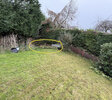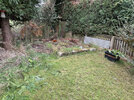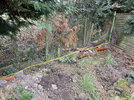I'd like to build a medium sized (let's say 4x3 m) room at the top of my garden where there's currently the wreck of a shed. The area is at the top of a slope. There's also a drainage ditch for the adjacent farm field on the other side so the area sits on a sort of plateau. I guess this is potentially an issue for subsidence if I build a heavy structure on a concrete slab. Is a fairly thick concrete slab (atop compacted type 1 MOT) likely going to be ok for this location or should I be looking to stabilise it more - I don't know if e.g. piles are an option for a home project or maybe a retaining wall? Or a different type of foundation altogether perhaps?
Photos of the area attached. First shows highlighted in yellow the area I want to build the room, with the sloping garden up to it. Second shows a closer view and the third shows the boundary (highlighted in yellow) backing onto a drainage ditch.
Photos of the area attached. First shows highlighted in yellow the area I want to build the room, with the sloping garden up to it. Second shows a closer view and the third shows the boundary (highlighted in yellow) backing onto a drainage ditch.




